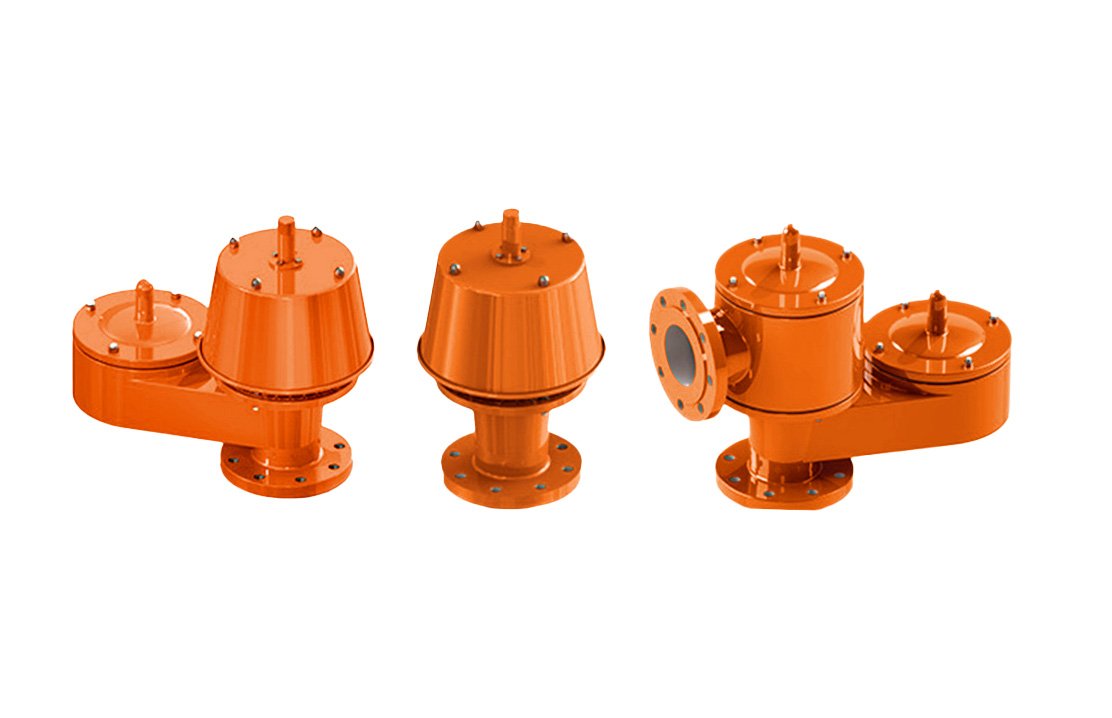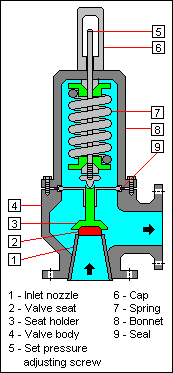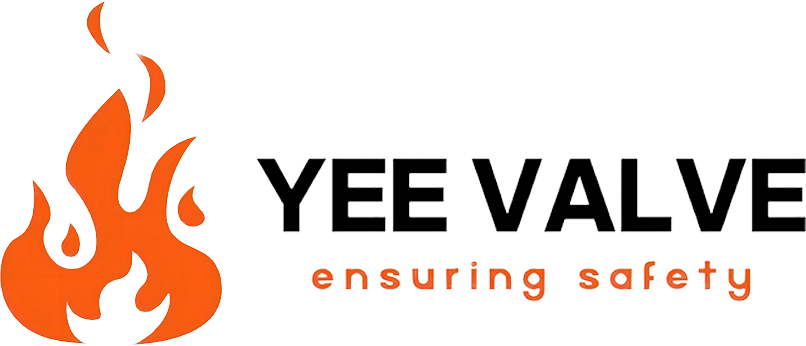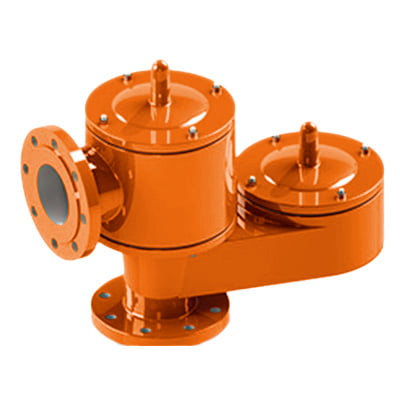Endüstriyel üretim süreci için güvenlik ve verimliliği sağlamak için doğru valfin seçilmesinin önemli olduğunu hepimiz biliyoruz. Havalandırma valfleri ve basınç tahliye vanaları (PRV'ler), benzer fonksiyonları nedeniyle sıklıkla karıştırılan iki yaygın olarak kullanılan valftir. Bu makale, bir havalandırma valfi ve basınç tahliye vanası arasındaki farkları hızlı bir şekilde anlamanıza neden olacaktır.
Havalandırma vanaları ve basınç tahliye vanaları (PRV'ler) endüstriyel sistemlerde güvenli basınç seviyelerini korumak için çok önemlidir. Her ikisi de aşırı basınç birikmesini önlerken, ancak
Havalandırma valfleri, ağırlık yüklü veya yaylı paletler kullanarak, kapalı kaplarda hem basıncı hem de vakumu yönetir.
PRV'ler, önceden belirlenmiş bir basınç noktasında açarak ekipmanı potansiyel hasardan koruyarak bir sistemdeki aşırı basıncı hafifletmek için tasarlanmıştır.
Bir havalandırma valfi ve basınç tahliye vanası arasındaki fark nedir?
Birçok durumda, havalandırma valfine basınç/vakum tahliye vanaları denir. Aynı adla birçok farklı terim olduğunu açıklayayım, ancak valf türü ve işlevi tamamen farklı. Buradaki basınç tahliye vanası, esas olarak valf basınç tahliye noktasını yayın önceden ayarlanmış kuvveti boyunca kontrol eden geleneksel bir boru hattı basınç tahliye vanasıdır. Tabii ki, havalandırma valfi, basınç veya vakum negatif basıncı nispeten yüksek olduğunda yay yükünü de kullanacaktır. Burada havalandırma valfi ve genel basınç tahliye vanası arasındaki farkı karşılaştırıyoruz.
Havalandırma valfı

İşlev
Havalandırma valfi, diğer terim basınç/vakum tahliye vanası (PVRV) olarak adlandırılır, tankları ve gemileri aşırı basınç ve vakum koşullarından korumak için tasarlanmıştır. Doldurma ve boşaltma gibi normal operasyonlar sırasında iç ve dış basıncı dengelemek için tank içine ve dışına kontrollü bir gaz akışına izin verir.
Ameliyat
Valf, tankın içindeki basınç belirli bir eşiği aştığında, aşırı basınç (havalandırma) serbest bıraktığında veya bir vakum tespit edildiğinde, havanın tanka girmesine izin verdiğinde açılarak çalışır. Bu, basınç dalgalanmalarının neden olduğu tankın hasarını önler.
Uygulamalar
Buhar kaybını en aza indirmek ve tankta yapısal hasarı önlemek için uçucu sıvılar için depolama tanklarında yaygın olarak kullanılır.
Basınç tahliye valfi
Bir basınç tahliye vanası (PRV), bir sistemdeki basıncı kontrol etmek veya sınırlamak için kullanılan bir tür emniyet vanasıdır. Sistemdeki basınç çok yükselirse, bir süreç, alet veya ekipman arızası, patlama veya yangına neden olabilir.
İşlev
Bir basınç tahliye vanası öncelikle bir sistemde felaket arızası veya patlamaya yol açabilecek aşırı basıncı önlemek için tasarlanmıştır. Aşırı basıncın kaçmasına izin vermek için önceden belirlenmiş bir set basıncında açılan bir güvenlik cihazıdır.
Ameliyat
PRV'ler, basınç valfin ayar noktasını aştığında sistemden aşırı basıncı boşaltmak için tamamen açılır. Basınç güvenli seviyelere indirildikten sonra, valf akışı durdurmak için kapanır.
Uygulamalar
PRV'ler, aşırı basınç koşullarının ekipman arızasına veya güvenlik tehlikelerine yol açabileceği boru hatları, reaktörler ve basınç kapları gibi çeşitli sistemlerde kullanılır.

Anahtar farklılıklar
İşlevsellik
Havalandırma valfleri, bir tankta hem basıncı hem de vakumu kontrol ederek normal tank işlemleri sırasında güvenli çalışma koşullarını korur. Basınç tahliye vanaları öncelikle acil durumlarda aşırı basınç bırakarak aşırı basıncını önleyen güvenlik cihazlarıdır.
Ayar Noktaları
Havalandırma valfleri, tipik olarak çok daha düşük basınç diferansiyellerinde çalışan, hem basınç hem de vakum için belirgin noktalara sahiptir.
PRV'ler tipik olarak sistem arızasına neden olabilecek aşırı basınç koşullarını önlemek için daha yüksek basınçlara ayarlanır.
Başvuru
Havalandırma valfleri tipik olarak atmosferik depolama tanklarında kullanılırken, basınç tahliye vanaları aşırı basınçın sıkı bir şekilde kontrol edilmesi gereken çok çeşitli basınçlı sistemlerde kullanılır.


Havalandırma Valfi ve PRV Basınç Tahliye Valfi
Hepimiz doğru vanayı seçmenin güvenliği ve verimliliği sağlamak açısından önemli olduğunu biliyoruz [...]
Ağustos
Havalandırma Valfi Test Prosedürü
Endüstriyel tank sistemlerinde havalandırma valfi, tankın [...]
Ağustos
Doğru Havalandırma Valfını Hızla Seçmek İçin 3 Basit Adım
YeeValve, THINKTANK'ın havalandırma valfleri üreten özel bir bölümüdür. Ücretsiz danışmanlık sunuyoruz [...]
Ağustos
Service & Technical Support
1. Teknik Yardım Yee Valve, valf seçimi, kurulumu ve bakımı için uzman rehberliği sunar. Müşteriler [...]
Mayıs
Sipariş Kontrol Listesi
Yee Valve'a sipariş verdiğinizde izlemeniz gereken adımlar şunlardır [...]
Mayıs
Havalandırma Valfinin Boyutlandırılması Nasıl Yapılır?
Bir havalandırma valfini uygun şekilde boyutlandırmak için şu adımları izleyin: Adım 1. Tank Özelliklerini Belirleyin Ölçün [...]
Mayıs